|
|
The Zionist enemy exceeded in his destructive
war on Lebanon all what has been confirmed by
international conventions, and human laws issued
by different international organizations and
Human Rights law, regarding the protection of
civilians, civil goals, and individuals who do
not participate in the war operations.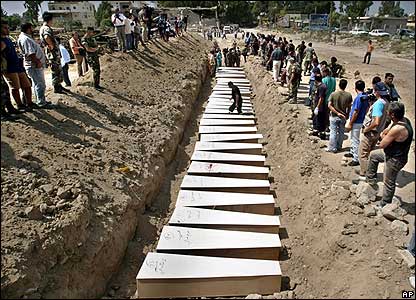
This arrogant enemy neglected all conventions
and international laws related to protecting
civilians, so it launched broad attacks against
civil public infrastructure in Lebanon, without
taking into regard these conventions and
international laws, yet challenging them.
The aggression did not stop at demolished
houses, burnt farms, or martyred civilians, but
it also included burning woods and animal farms,
and causing an environmental pollution which
Lebanon would suffer for a long time.
During 33 days of land, aerial, and maritime
bombarding on Lebanon by "Israeli" troops, the
main infrastructure of the country was highly
destructed to a catastrophic extent.
The "Israeli" air force launched more than 7000
air strikes, while the naval warships launched
2500 raids. The buildings therefore were razed
to the ground, and whole neighborhoods turned
into piles of dust, while villages and towns
were like ghost towns. Main roads, bridges, and
gas stations blasted and scattered into wreck.
Houses were destructed over its residing people,
so entire families martyred, and cars were burnt
with its drivers. The "Israeli" death machine
was a leader in crime for it has recorded in the
history of mankind, the most vicious massacres
in the modern era. The aggression went too far,
where tens of martyrs stayed buried underground
of their houses' rubbles for weeks, while the
civil defense and other rescue missions were not
allowed entry to the afflicted areas;
considering them as "Israeli" targets.
The infrastructure was not safe, for the
airports, ports, water and sewage stations,
electricity stations, bridges, roads, gas
stations, and trade institutions were also
raided.
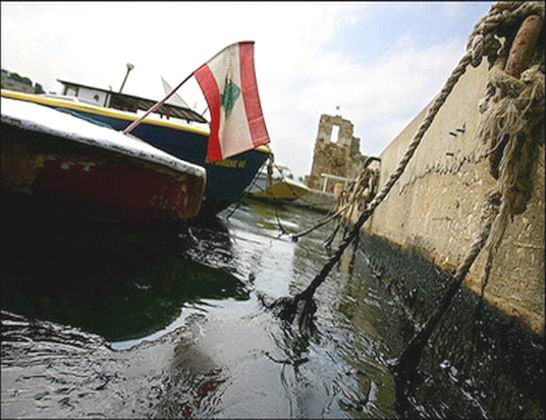
Damages Affecting Water Facilities
Many wells, water pipes, storage tanks, pumping
stations and water treatment facilities were
destroyed in various parts of southern Lebanon.
Moreover, the water network in the country was
shut down, because the water pipes beneath the
roads were extensively damaged when the upper
roads were bombed.
Damages Affecting Power Plants and Fuel Supplies
Electricity facilities, power plants and fuel
stations suffered extensive damages. At least 20
fuel depots were completely destroyed due to air
raids, and 25 gas stations were destroyed or
severely damaged.
Damage Affecting Beirut International Airport
Beirut International Airport was targeted
repeatedly by naval warships and Zionist
aircraft. It was one of the first targets hit,
where the first air attack turned the fuel tanks
into inflamed fireballs, while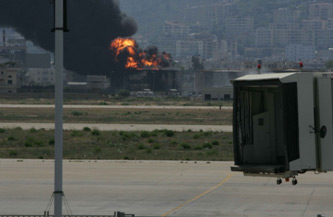 another round of strikes left behind craters in
the three main airport runways.
another round of strikes left behind craters in
the three main airport runways.
Damages Affecting Ports
The Zionist troops attacked the sea ports along
the Lebanese coast, without taking into account
any humanitarian treaties or the Human Rights
Charter. The Zionist war machine did not leave
behind any side of Lebanon's coast but targeted
it with barbaric fire, or contaminated it by
leaking fuel from the shelling. All ports were
therefore shut down from business, including the
three main sea ports in Beirut, Tripoli and
Saida.
Damages Affecting Hospitals
Hospitals were not safe in many areas in the
country; they suffered severe damages due to the
bombing, especially in the south, where two
governmental hospitals in Bent Jbeil and Meis
el-Jabal were completely destroyed by the
"Israeli" barbaric attacks. Three other
hospitals were severely damaged in the Beirut
southern suburb, and they were forces to closure
due to shelling surrounding it on a daily basis.
Dar al-Hekma hospital, which "Israelis" claimed
was the headquarters of the resistance
leadership, was directly attacked. On August 2,
the hospital was attacked by the "Israeli"
commandos on helicopters, supported by fighter
jets and spy drones, in the city of Baalbek in
the eastern Bekaa Valley. The Zionist army
claimed it abducted five resistance members. In
the village of Tibnin southern Lebanon, few
hours before the fire cease in August 14,
"Israeli" troops launched cluster bombs around
the governmental hospital where hundreds of
civilians were keeping shelter. The outer walls
of the hospital were damaged.
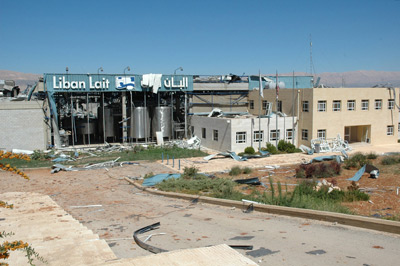
Damages Affecting Main Economic
Infrastructure
- Bombing electricity power plants and fuel
storage areas
- Bombing 31 industrial facilities
- Completely demolishing sever presses
- Totally destroying 38 publishing houses, with
more than 10 million burnt books, leading the
Publishers Association call this aggression as
the Holocaust of Books
- Burning more than 2000 vehicles
- Destructing and damaging more than 700
supermarkets and shops
Surveying the damage in the agricultural
infrastructure:
- 1800 hectares of forests and forest areas were
subject to direct damages due to fires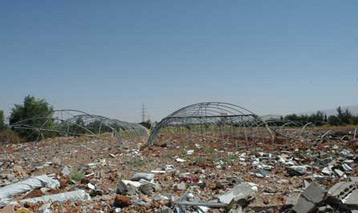
- Incalculable loss was marked in the fisheries
and animal and poultry farms
- More than ten agricultural warehouses were
demolished, leading to the infiltration of
pesticides and natural fertilizers
- More than 3000 milk-producing cattle were
killed
- More than 1250 bulls were killed
- More than 15000 goats and sheep were killed
- More than 19000 beehives were affected
- More than 600000 chickens were killed.
Surveying Damage in the Fisheries and the
Compensations:
Some 7585 fishermen spread over 42 fishing
points were damaged directly and indirectly.
They were surveyed, and symbolic gifts were
presented as compensation for their loss caused
to them by the "Israeli" aggression on Lebanon
(July 2006).
|